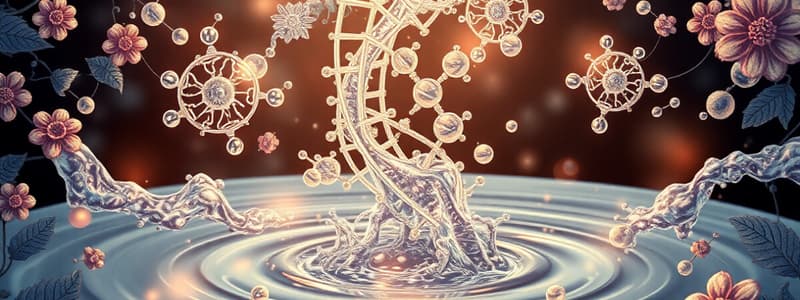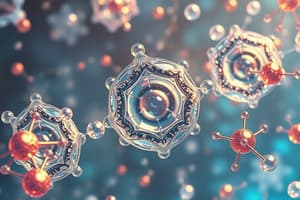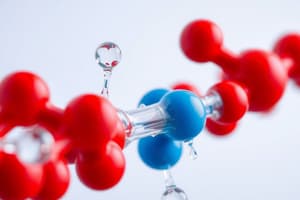Podcast
Questions and Answers
What property of water allows it to moderate temperature?
What property of water allows it to moderate temperature?
- Solvent capabilities
- Cohesion
- Lattice formation
- High specific heat capacity (correct)
Water molecules are more ordered in their liquid state than in their solid state.
Water molecules are more ordered in their liquid state than in their solid state.
False (B)
What type of substances can dissolve easily in water?
What type of substances can dissolve easily in water?
Polar and charged substances
The pH of blood must be kept between ______ and ______.
The pH of blood must be kept between ______ and ______.
Which of the following explains why ice floats on water?
Which of the following explains why ice floats on water?
Hydrophobic substances can easily interact with water.
Hydrophobic substances can easily interact with water.
What is a hydrocarbon?
What is a hydrocarbon?
Different chemical structures lead to different chemical _________.
Different chemical structures lead to different chemical _________.
Match the following properties of water with their descriptions:
Match the following properties of water with their descriptions:
What are functional groups?
What are functional groups?
Which of the following statements is true about carbohydrates?
Which of the following statements is true about carbohydrates?
Lipids are hydrophilic molecules that dissolve easily in water.
Lipids are hydrophilic molecules that dissolve easily in water.
What is the storage polysaccharide of animals?
What is the storage polysaccharide of animals?
The resulting bond formed between monosaccharides during dehydration synthesis is called a _________.
The resulting bond formed between monosaccharides during dehydration synthesis is called a _________.
Match the following types of fatty acids with their descriptions:
Match the following types of fatty acids with their descriptions:
Which class of biological molecules does glycogen belong to?
Which class of biological molecules does glycogen belong to?
Proteins are made from a limited number of amino acids.
Proteins are made from a limited number of amino acids.
What type of bond is formed between amino acids when creating proteins?
What type of bond is formed between amino acids when creating proteins?
In proteins, the sequence of amino acids determines the primary _________.
In proteins, the sequence of amino acids determines the primary _________.
What are sterols characterized by?
What are sterols characterized by?
What process allows DNA to make a new copy of itself?
What process allows DNA to make a new copy of itself?
Enzymes can function without their cofactors.
Enzymes can function without their cofactors.
What is the term for the inactive form of an enzyme?
What is the term for the inactive form of an enzyme?
DNA consists of the nitrogenous bases A, G, C, and _____ .
DNA consists of the nitrogenous bases A, G, C, and _____ .
Match the type of RNA with its primary function:
Match the type of RNA with its primary function:
Which component is part of a nucleotide?
Which component is part of a nucleotide?
The purines A and G have a single-ring structure.
The purines A and G have a single-ring structure.
What is the biological importance of ATP?
What is the biological importance of ATP?
Bonds are made and broken during the ________ process that occurs in enzyme action.
Bonds are made and broken during the ________ process that occurs in enzyme action.
What term describes the specificity of enzyme activity with its substrate?
What term describes the specificity of enzyme activity with its substrate?
Which of the following substances are hydrophilic?
Which of the following substances are hydrophilic?
Water expands upon freezing, causing ice to float.
Water expands upon freezing, causing ice to float.
What is the range of pH levels that blood must be kept between?
What is the range of pH levels that blood must be kept between?
Water is a polar molecule, which allows it to be an excellent __________.
Water is a polar molecule, which allows it to be an excellent __________.
Match the following properties of water with their descriptions:
Match the following properties of water with their descriptions:
Which statement correctly describes functional groups?
Which statement correctly describes functional groups?
Hydrophobic substances can easily dissolve in water.
Hydrophobic substances can easily dissolve in water.
Define what a hydrocarbon is.
Define what a hydrocarbon is.
What is the function of enzymes in biological reactions?
What is the function of enzymes in biological reactions?
Denatured proteins lose their structure and remain biologically active.
Denatured proteins lose their structure and remain biologically active.
What are the monomers of nucleic acids called?
What are the monomers of nucleic acids called?
Enzymes are often regulated by the presence of _____, which are nonprotein molecules assisting in catalysis.
Enzymes are often regulated by the presence of _____, which are nonprotein molecules assisting in catalysis.
Match the types of RNA with their primary function:
Match the types of RNA with their primary function:
Which type of bond forms between amino acids during protein synthesis?
Which type of bond forms between amino acids during protein synthesis?
ATP serves as the energy currency of cells.
ATP serves as the energy currency of cells.
What is the inactive form of an enzyme called?
What is the inactive form of an enzyme called?
_____ is the process through which DNA is copied to form a new DNA molecule.
_____ is the process through which DNA is copied to form a new DNA molecule.
Which of the following nucleotides are present in RNA?
Which of the following nucleotides are present in RNA?
Which of the following is NOT a class of biological monomer?
Which of the following is NOT a class of biological monomer?
Lipids contain more oxygen atoms than carbohydrates.
Lipids contain more oxygen atoms than carbohydrates.
What is the main storage polysaccharide in plants?
What is the main storage polysaccharide in plants?
Monosaccharides are linked together by __________ synthesis.
Monosaccharides are linked together by __________ synthesis.
Match the following types of lipids with their descriptions:
Match the following types of lipids with their descriptions:
What type of bond connects amino acids in a protein?
What type of bond connects amino acids in a protein?
Saturated fats contain only single covalent bonds.
Saturated fats contain only single covalent bonds.
What is the monomer of proteins?
What is the monomer of proteins?
The bond formed between monosaccharides is called a _________ linkage.
The bond formed between monosaccharides is called a _________ linkage.
Which type of fatty acid has one or more double bonds?
Which type of fatty acid has one or more double bonds?
Humans can digest cellulose easily.
Humans can digest cellulose easily.
What is the difference between a peptide and a protein?
What is the difference between a peptide and a protein?
Sterols are characterized by a __________ group.
Sterols are characterized by a __________ group.
Match the following carbohydrates with their functions:
Match the following carbohydrates with their functions:
What are the four main classes of biological molecules?
What are the four main classes of biological molecules?
Flashcards are hidden until you start studying
Study Notes
Water Properties
- Water exhibits cohesion due to hydrogen bonds between water molecules.
- Water has a high heat capacity, absorbing a lot of energy before its temperature increases. This helps moderate temperature, keeping daytime temperatures low and releasing heat at night.
- Water expands upon freezing, making ice less dense than liquid water. This allows aquatic organisms to survive winter.
- Water is a polar molecule, making it a good solvent for polar and charged substances. These substances are called hydrophilic.
- Hydrophobic substances, like lipids, do not dissolve in water.
- Buffers minimize changes in pH levels, crucial for biological systems. Blood, primarily water, maintains a pH between 7.35-7.45.
Organic Molecules
- Organic molecules contain carbon, forming carbon skeletons held together by covalent bonds.
- Hydrocarbons contain only carbon and hydrogen.
- Functional groups are atoms or molecules attached to the carbon skeleton, altering the molecule's properties.
Biological Molecules
- Biological molecules are complex organic compounds made from a few basic subunits, primarily as polymers.
- Four classes of biological monomers: carbohydrates, lipids, proteins, and nucleic acids.
Carbohydrates
- Contain carbon, hydrogen, and oxygen.
- Monosaccharides are simple sugars, the monomers of carbohydrates.
- Dehydration synthesis joins monosaccharides, forming glycosidic linkages.
- Disaccharides are formed from two monosaccharides.
- Polysaccharides are large polymers of monosaccharides.
- Glycogen, the storage polysaccharide of animals, is a branched chain of glucose monomers.
- Starches, the storage polysaccharide of plants, are linear chains of glucose monomers.
- The difference between glycogen and starches lies in the stereochemistry of the glycosidic bonds.
- Humans lack the enzyme to break down cellulose.
Lipids
- Hydrophobic molecules made of carbon, hydrogen, and a small proportion of oxygen.
- Types of lipids include fatty acids, triglycerides, phospholipids, steroids, eicosanoids, and fat-soluble vitamins.
- Fatty acids are hydrocarbon chains with a carboxyl group at one end.
- Saturated fatty acids contain only single C-C bonds.
- Unsaturated fatty acids contain one or more C-C double bonds.
- Triglycerides are composed of three fatty acids bonded to a glycerol backbone.
- Fats are triglycerides that are solid at room temperature, while oils are liquid.
- Triglycerides are stored in fat cells.
- Phospholipids have a polar phosphate head (hydrophilic) and hydrophobic fatty acid tails, making them amphipathic.
- Steroids are formed by four fused carbon rings.
- Cholesterol is the starting molecule for other steroids and plays a role in membrane fluidity.
- Eicosanoids, including prostaglandins and leukotrienes, are involved in immune signaling.
- Fat-soluble vitamins, such as D, E, and K, are essential for human health.
Proteins
- Large molecules of carbon, hydrogen, oxygen, and nitrogen.
- Monomers are amino acids (20 naturally occurring).
- Amino acids have a central carbon atom bonded to an amino group, a carboxyl group, and a unique R group.
- Dehydration synthesis forms peptide bonds between amino acids.
- A peptide is a short chain of amino acids, while a polypeptide is a longer chain.
- Protein structure determines function.
- Primary structure is the amino acid sequence, dictated by the gene.
- Secondary structure involves repeated folds (α-helices or β-sheets) stabilized by hydrogen bonds.
- Tertiary structure is the three-dimensional shape, determined by primary and secondary structure, and bonds like disulfide bridges, hydrogen bonds, and hydrophobic interactions.
- Quaternary structure is the arrangement of multiple polypeptide chains in multi-peptide proteins.
- Fibrous proteins are long parallel bundles and water-insoluble (e.g., keratin, actin).
- Globular proteins are round and water-soluble (e.g., antibodies, enzymes).
- Denatured proteins lose their structure and become biologically inactive.
Enzymes
- Biological catalysts that accelerate the rate of chemical reactions without being consumed in the process.
- Nonprotein molecules assisting enzymes are called cofactors. Organic cofactors are called coenzymes.
- Enzymes are essential for chemical reactions in the body.
How Enzymes Work
- Substrates bind to the active site of an enzyme, forming the substrate-enzyme complex.
- Chemical changes occur, bonds are made or broken, and atoms are rearranged.
- Reaction products are released, and the enzyme is free to act on more substrate.
- Enzymes increase reaction rates by lowering activation energy.
- Activation energy is the minimum energy needed to start a reaction.
Characteristics of Enzymes
- Highly specific: Substrates fit the active site of enzymes through a "lock and key" mechanism.
- Efficient: Enzymes increase the rate of reactions by lowering activation energy.
- Regulated: Cells control enzyme synthesis and activity. Proenzymes are inactive forms of enzymes that must be processed to become active.
Nucleic Acids
- Contain carbon, hydrogen, oxygen, nitrogen, and phosphorus.
- DNA (deoxyribonucleic acid) and RNA (ribonucleic acid) are the two types.
- DNA carries genetic information, while RNA plays a crucial role in protein synthesis.
- Monomers are nucleotides, composed of a nitrogenous base, a pentose sugar, and a phosphate group.
- DNA bases: A, G, C, and T
- RNA bases: A, G, C, and U
- Purines (A, G) have double-ring structures, while pyrimidines (T, C, U) have single-ring structures.
- DNA's pentose sugar is deoxyribose, while RNA's sugar is ribose.
- The phosphate groups and sugar molecules form the backbone of the nucleic acid molecule.
- DNA forms a double helix due to the properties of nucleotides with complementary base pairing (A-T, G-C).
- DNA replication creates a new copy of the DNA double helix using one strand as a template.
- A change in the nucleotide sequence of DNA is called a mutation.
- RNA is single-stranded and exists in three forms:
- Messenger RNA (mRNA) carries the genetic code from DNA to ribosomes.
- Ribosomal RNA (rRNA) is a component of ribosomes, the protein synthesis machinery.
- Transfer RNA (tRNA) carries amino acids to ribosomes during translation.
Adenosine Triphosphate (ATP)
- The energy currency of cells.
- Consists of three phosphate groups bound to adenosine.
- ATP is produced by exergonic cellular reactions and consumed by endergonic reactions to do cellular work.
- Hydrolysis of the terminal phosphate group releases energy.
- ATP can be regenerated through ATP synthase during aerobic cellular respiration.
Summary
- Biological molecules are diverse organic molecules essential for living organisms.
- Four classes: carbohydrates, lipids, proteins, and nucleic acids.
- All are polymers except lipids.
- Structure and function are closely linked in biological molecules.
Water Properties
- Water exhibits cohesion due to hydrogen bonds between molecules.
- Water has a high heat capacity, moderating temperature changes.
- Water expands upon freezing, making ice less dense than liquid water, allowing aquatic life to survive in colder temperatures.
- Water is a polar solvent, dissolving polar and charged substances (hydrophilic).
- Hydrophobic substances, like oils and lipids, do not dissolve in water.
- Buffers help maintain pH levels, like in blood which is mostly water.
Organic Molecules
- Organic molecules contain carbon.
- Hydrocarbons are organic molecules containing only carbon and hydrogen.
- Functional groups modify carbon skeletons, providing unique chemical properties to molecules.
Biological Monomers
- Polymers are large molecules made of repeating subunits called monomers.
- Biological monomers include carbohydrates, lipids, proteins, and nucleic acids.
Carbohydrates
- Carbohydrates contain carbon, hydrogen, and oxygen.
- Monosaccharides are simple sugars and the monomers of carbohydrates.
- Disaccharides are formed by joining two monosaccharides.
- Polysaccharides are large molecules made of many monosaccharides.
- Glycogen is a storage polysaccharide in animals.
- Starch is a storage polysaccharide in plants.
- Cellulose is a structural polysaccharide found in plant cell walls, indigestible by humans.
Lipids
- Lipids are hydrophobic molecules made of carbon, hydrogen, and a small amount of oxygen.
- Fatty acids are hydrocarbons with a carboxyl group.
- Triglycerides are composed of three fatty acids bonded to a glycerol molecule.
- Saturated fatty acids have only single bonds in their carbon chain.
- Unsaturated fatty acids contain one or more double bonds in their carbon chain.
- Phospholipids are amphipathic molecules, with a hydrophilic phosphate head and hydrophobic fatty acid tails.
- Steroids are lipids with four fused carbon rings, including cholesterol.
- Eicosanoids are 20-carbon compounds involved in immune signaling.
Proteins
- Proteins contain carbon, hydrogen, oxygen, and nitrogen.
- Amino acids, with their unique R groups, are the monomers of proteins.
- Peptide bonds form between amino acids through dehydration synthesis.
- Polypeptides are chains of amino acids.
- Protein structure determines its function.
- Primary structure is the amino acid sequence.
- Secondary structure includes alpha-helices and beta-sheets.
- Tertiary structure refers to the three-dimensional shape of a protein.
- Quaternary structure is the arrangement of polypeptide chains in multi-peptide proteins.
- Fibrous proteins are long and insoluble in water.
- Globular proteins are spherical and soluble in water.
- Denaturation is the loss of protein structure, rendering it inactive.
Enzymes
- Enzymes are biological catalysts, accelerating chemical reactions without being consumed.
- Cofactors are nonprotein molecules that assist enzyme activity.
- Coenzymes are organic cofactors.
- Enzymes are highly specific, binding substrates at their active sites.
- Enzymes are efficient, lowering activation energy and increasing reaction rates.
- Enzymes are regulated, with cells controlling their synthesis and activity.
Nucleic Acids
- Nucleic acids contain carbon, hydrogen, oxygen, nitrogen, and phosphorus.
- DNA and RNA are the two types of nucleic acids.
- Genes are segments of DNA that code for specific proteins.
- DNA is transcribed to RNA, which is translated into proteins by ribosomes.
- Nucleotides, the monomers of nucleic acids, consist of a nitrogenous base, a pentose sugar, and a phosphate group.
- DNA contains adenine (A), guanine (G), cytosine (C), and thymine (T).
- RNA contains adenine (A), guanine (G), cytosine (C), and uracil (U).
- Purines (A and G) are double-ring bases.
- Pyrimidines (T and C or U) are single-ring bases.
- DNA has a deoxyribose sugar, while RNA has a ribose sugar.
- The phosphate groups and sugars form the backbone of the nucleic acid molecule.
- DNA forms a double helix due to base pairing: A with T and G with C.
- DNA replication produces a new copy of the DNA molecule.
- Mutations are changes in the nucleotide sequence of DNA.
- RNA is single-stranded and exists in three main types: messenger RNA (mRNA), ribosomal RNA (rRNA), and transfer RNA (tRNA).
ATP
- Adenosine triphosphate (ATP) is the energy currency of cells.
- ATP consists of three phosphate groups bound to adenosine (adenine + ribose).
- ATP is produced by exergonic cellular reactions.
- ATP is consumed by endergonic cellular reactions to do cellular work.
- ATP hydrolysis releases energy by breaking a phosphate bond.
- ATP synthesis is catalyzed by ATP synthase during aerobic respiration.
Studying That Suits You
Use AI to generate personalized quizzes and flashcards to suit your learning preferences.




